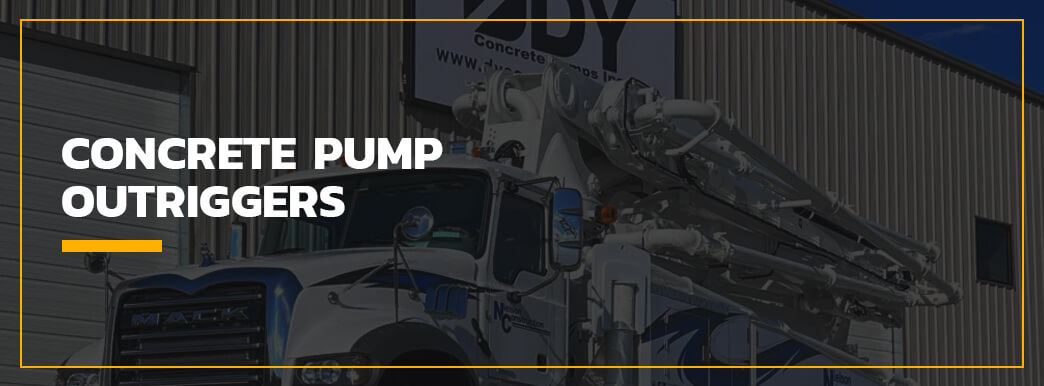Concrete Pump Outriggers
Posted On: 01/27/2023 | Posted by: DY Concrete Pumps

Concrete boom pumps increase safety and improve productivity on the work site by removing most of the manual labor from the concrete pour. Pumps are especially beneficial in hard-to-reach places because they deliver the concrete exactly where it needs to go before it begins setting. Before pumps became mainstream, builders and contractors used tools like wheelbarrows, shovels and buckets to distribute concrete around their work areas, adding endless hours to their operations.
Despite the advantages, using the proper safety procedures when operating a concrete pump is still paramount. Stabilization and overloading problems can cause a boom pump to tip over when unbalanced. Stabilizing your boom pump with the appropriate outrigger can eliminate these issues and ensure safe pouring.
What Are Concrete Pump Outriggers?
Outriggers are retractable legs that extend out and away from a boom pump before contacting the ground. They provide a stable base for a pumping operation by distributing the pump’s load over a broader area. Without outriggers, the boom’s maneuverability would be significantly limited.
Operators often use cribbing — or outrigger pads — when a surface isn’t strong enough to support the outrigger’s pressure. Cribbing prevents small changes or shifts in the soil from affecting the outrigger’s structural integrity. The pad’s purpose is to absorb the weight of the pump and provide the outrigger with a stable surface.
Types of Outriggers
Depending on the size and functionality of a concrete pump, manufacturers utilize several outrigger styles. At DY Concrete Pumps, we offer outrigger designs like:
- X-type outriggers: X-outrigger beams overlap each other to form an X-shape. This type of outrigger system typically fits on the front end of a concrete boom pump. DY Concrete Pumps utilizes X-style designs on multiple boom pump models, including the 63X-5RZ, 57X-6RZ, 52X-5RZ, 48X-5RZ and others.
- Swing-out, telescope and extend-down outriggers: These types of outriggers are also typically on the front of a concrete boom pump. The telescoping feature allows the length of the outrigger to adjust according to your site and load requirements. DY boom pump models using this design on the front end include the 57S-6RZ, 33X-5ZZ and 21X-4R.
- Swing and extend-down: DY uses swing and extend-down hydraulic outriggers for nearly all our boom pump models, with spreads reaching as far as 47 ½ feet on the 63X-5RZ model.
- Vertical jacks: Vertical outriggers provide stability for smaller trailer pumps or concrete line pumps like our TP-50 and TP-70 models. These outriggers sit at the rear of the unit and extend to the ground vertically using hydraulics.
How Do Outriggers Work?
Many outrigger designs function as their respective name applies. Outriggers with telescoping features can extend to various lengths based on the specific requirements of the load and the terrain. All outrigger designs provide stability to the concrete pump by applying downward pressure to the ground.
When working with outriggers, operators must carefully inspect the terrain for slopes, trenches, loose soil or other factors that might compromise the equipment’s stability. In addition, different types of soils have various load-bearing capacities that can affect outrigger deployment.
Extending the boom over each outrigger before pumping can help the operator determine whether the outrigger is sinking into the ground. If the operator cannot stabilize the outriggers, they should not pour the concrete until they find a more stable location.
Benefits of Using Outriggers
Equipping your concrete pump with the optimal outriggers for your specific application allows you to experience benefits like:
- Stability: The primary role of an outrigger is keeping the pump from tipping over. When the boom extends, the outriggers distribute the weight and force across the machine’s entire footprint. Without outriggers, booms would have significantly limited reach capacities.
- Safety: When an operator correctly deploys a pump’s outriggers, it exponentially increases the safety around a job site for the workers and the equipment. The National Institute for Occupational Safety and Health estimates that nearly 80% of boom collapses and crane tip-overs happen because operators exceed the device’s load capacity, with over 50% occurring due to improper outrigger placement.
- Versatility: Multiple outrigger configurations on concrete boom pumps allow them to operate on challenging terrain. Outriggers can stabilize the pump even when on sloped or uneven ground.
- Efficiency: Built-in outriggers save your operation significant time over manually placing boards and other materials on the ground to create stability. DY Concrete Pumps uses outriggers that deploy quickly and require minimal setup time, ensuring maximum efficiency for your pumping operation.
- Compliance: Understanding Standard 1926.1400 of the Occupational Safety and Health Administration is essential for any operator or company utilizing a boom lift or any other model of power equipment that can maneuver a suspended load. This standard involves supporting material definitions and fundamental ground conditions. OSHA Standard 1926.1401 pertains to cribbing and other materials for load distribution.
Contact DY Concrete Pumps for a Quote on Your Next Boom Pump
With over four decades of industry experience, DY Concrete Pumps is a proud market leader in this sector. Whether you need a boom pump with X-style or swing-out outriggers, our knowledgeable technical staff and sales team can help you find the perfect solution for your application. Connect with us online today to obtain a quote and learn more about how our pumps can increase your operation’s productivity and efficiency.


 1-844-397-8677
1-844-397-8677


